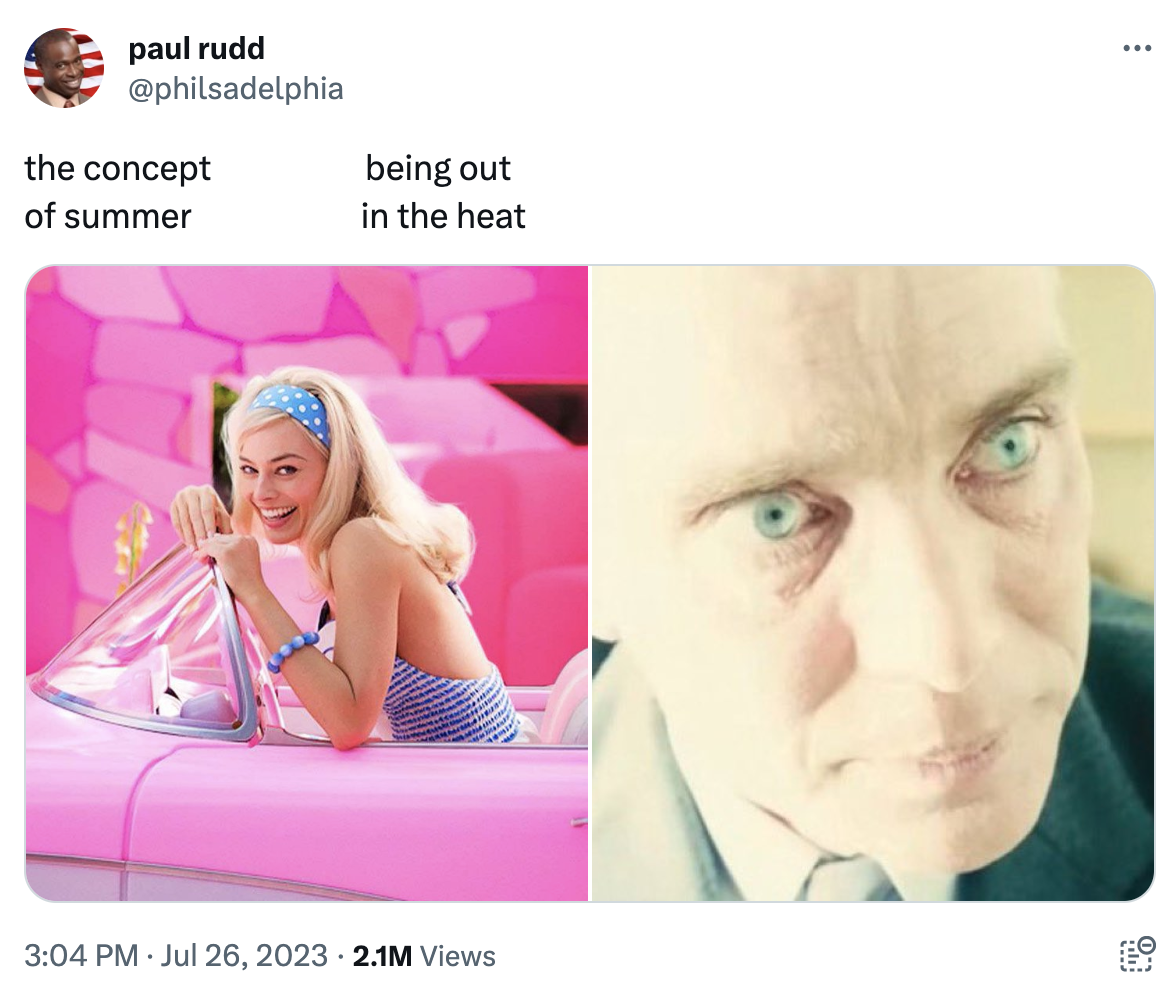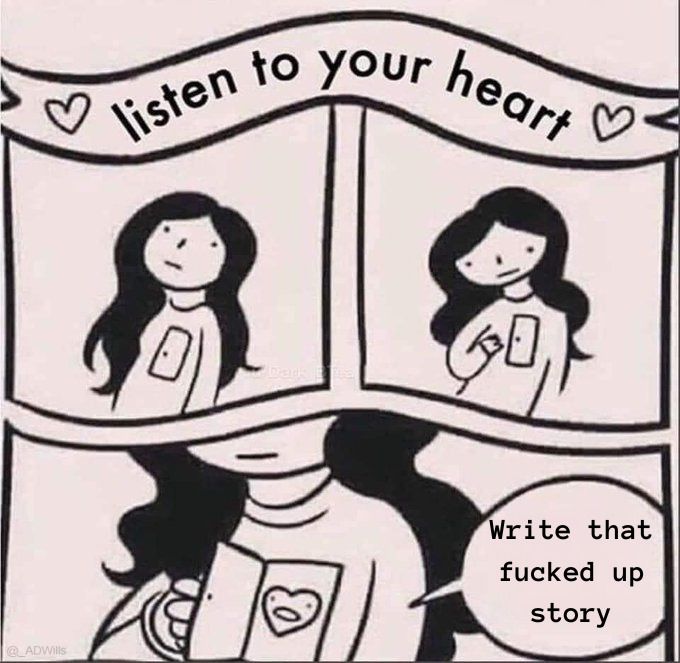Issue 76: Variations on a theme
This past weekend, I took a Tin House craft intensive with Elaine Hsieh Chou on what film and TV can teach us about stories and novels. An optional part of our homework was listening to an episode of Scriptnotes, a podcast hosted by John August (Charlie’s Angels, Big Fish) and Craig Mazin (Chernobyl, The Last of Us), called “How to Write a Movie.” My partner is a screenwriter and I’ve often overheard him listening to this podcast in the shower, so it was fun to finally listen to a full episode. The thing that stuck with me most was Mazin’s definition of theme.
When I first learned about literary themes, it was in ninth or tenth grade English class. These were things like “social inequality” and “the American Dream.” As a reader, this was sufficient to try and understand the underlying ideas of a novel or play (and write a passable essay). But as a writer, I’ve found screenwriting and film instructive in developing a new understanding of theme and its role in impactful storytelling.
Theme as dramatic argument
Similar to my high school self, people often mistake concepts for themes, like “sisterhood.” Mazin defines theme as your central dramatic argument. You can’t disagree with a vague topic like “sisterhood.” Examples of dramatic arguments include “men and women can’t be friends” (When Harry Met Sally), “hope is crucial for survival” (The Shawshank Redemption), or “if you love someone, set them free” (Finding Nemo).
The purpose of the story is to take a character from ignorance of the truth of the theme to embodiment of the theme through action.
Rather than thinking of plot as something that happens to your characters, your goal as the writer is to lead your characters from anti-theme to theme. Mazin operates in a character-oriented way, which I really love. You need to design moments that test your protagonist’s faith in the theme and ultimately make them prove their belief in it.
Characters should also embody the anti-theme. Mazin suggests subtlety here, as that tends to be more effective. I think The Shawshank Redemption, which I watched for the first time last week, does this beautifully. Although Andy has several antagonists in his fellow prisoners and the warden, the character that best represents the anti-theme is actually his best friend, Red. For Andy, “hope is crucial for survival.” For Red, “hope is useless and can drive a man insane.” But over the course of the movie, Andy helps Red develop optimism and a desire to change.
When it comes to formulating a theme for your story, Mazin has some helpful suggestions. The theme might be interesting or cliché, but the quality of the argument isn’t necessarily related to the quality of the script. The execution is ultimately what’s interesting. He encourages thinking ironically, to take your idea and think about what central dramatic argument might fit well with it. Just take Ratatouille—the theme is ”anyone can cook,” even a rat!
Theme as philosophical stakes
In his video essay, Endings: The Good, the Bad, and the Insanely Great, Michael Arndt (Little Miss Sunshine, Toy Story 3) defines theme as the story’s philosophical stakes, or underdog values vs. dominant values. These sets of values are in tension with one another throughout the story.
In Star Wars, the philosophical stakes are democracy, freedom, connection, and altruism vs. empire, violence, and greed. Han Solo is the philosophical antagonist, as he embodies the anti-theme of self-interest, but eventually learns to sacrifice for the greater good. In The Graduate, the philosophical stakes are more personal: true love and trusting your feelings vs. cynicism and social conformity.
According to Arndt, to craft an effective ending, you want the dominant values to be on the verge of defeating the underdog values. But then, there is a sudden reversal and the underdog values ultimately prevail. This sudden reversal of values overturns the moral order of the universe you’ve created, which becomes the meaning of your story.
Theme as moral vision
John Truby in The Anatomy of Story defines theme as moral vision. This is your view about right and wrong action in the world you’ve created, and what those actions do to a person’s life. Truby’s advice is to condense your theme to a single line (sound familiar?). The theme line “is not a highly nuanced expression of your moral vision.” Rather, it’s useful in that it forces you to tie various elements of the story back to a single moral idea.
Truby has some interesting analyses on how moral vision might appear differently depending on the genre. In a tragedy, the self-revelation for the hero comes too late. In a black comedy, you withhold the self-revelation from the hero to give it more strongly to the audience. Similar to Arndt, Truby believes theme contributes to strong endings.
In a good story, the story structure converges near the end at the same time that the theme expands in the mind of the audience.
Dialogue can also be used to form the moral argument. An ally can criticize the protagonist for taking an immoral action while trying to win the goal. The main opponent can give a justification for their actions during a battle with the protagonist. (Arndt calls this the “antagonist aria,” where you give depth to the opponent, and thereby the protagonist.)
Case study: Everything Everywhere All At Once
One of the best films to encapsulate all of this screenwriting advice on theme is Everything Everywhere All At Once (spoilers ahead). The theme is that when “nothing matters,” or when everyone is struggling with the meaninglessness of life, you don’t fight it with violence or apathy, but with kindness and empathy.
- Irony: There’s a deep irony between the theme and Evelyn’s character, who is on the brink of losing everything—her business, her marriage, and her daughter.
- Moral dialogue: Jobu Tupaki gets her antagonist aria where she describes why she wants to be sucked into the bagel, thereby reinforcing the anti-theme. Waymond has some of the best moral dialogue when he explains how he sees kindness as his own superpower.
- Protagonist's faith in the theme is tested: Alpha Waymond gets killed, Alpha Gong-Gong closes in with his fighters, and Deirdre’s tax audit proceeds. Evelyn is briefly persuaded to give into the anti-theme when she begins smashing things in the laundromat, but the underdog values of finding meaning in nothingness prevail.
- Reversal of values: The ending is particularly effective because there are several reversals of values in quick succession. She adopts Waymond’s philosophy of kindness to disarm the people standing between her and Joy. There’s a moment where it seems like she’ll let Joy get sucked into the bagel, but she only grips her harder, breaking the generational cycle of abandonment she experienced with her own father. This is then reinforced in the laundromat parking lot when Evelyn refuses to let Joy leave.
I used to think theme hovered over the story, but it’s actually a way of grounding your writing. The theme also doesn’t have to be the most groundbreaking argument. As Mazin says, it’s in your unique execution of the theme through your characters that the magic happens.


Creative resources
- I love Kara Cutruzzula’s advice to focus on percolation over productivity. This means “providing yourself time and space to think without tracking your performance. It’s reflection, exploration, generation.”
- “The Year of the Slim Volume” by Kate Dwyer
- The Pulitzers are poised to open their literary and arts awards to non-citizens, in large part due to advocacy from writers like Ingrid Rojas Contreras and Javier Zamora. It reminded me of a thoughtful essay by Amber Sparks on the mix of prestige, money, bias, and competition of literary prizes—and what these prizes are even for.
- The Resort is hosting an in-person, generative writing retreat in Queens on Oct 7-8. Catherine, the founder, is an amazing facilitator and The Resort community is always so supportive.
- Rebecca Meacham on mining other peoples' lives for art, “Imagining the consequences of our choices as writers, we want to steel ourselves for battle. [...] But what if we also imagined meeting consequence with compassion?”
Recent reads & other media
I really loved This Time Tomorrow by Emma Straub, which is a love letter from a daughter to her father. My friend recommended Ravishing the Heiress by Sherry Thomas and it was a great slow burn romance. I also got to check out The Ripped Bodice’s new Brooklyn location and it was a dream come true! It’s so welcoming and well-designed, with so many subgenres and recommendations.
Oppenheimer was a fascinating exploration of the banality of empire and the shadowy nature of power. My friend Sarah over at Boy Movies, in a Barbenheimer double feature, wrote about the film and I appreciated her perspective. Since I’d never seen Tenet, E broke out the Blu-ray and patiently paused the movie when I had questions. It was, as he described, Christopher Nolan doing his version of a James Bond movie. Although it was ultimately kind of silly and wasn’t my favorite Nolan movie, I can’t stop jokingly doing the Tenet hand gesture.
A friend and I saw Bottoms, which was surreal, violent, and laugh out loud hilarious. (Jeff from Bottoms is Ken from Barbie’s Wario.) My sister and I watched The Shawshank Redemption—or as Riverdale calls it, Shankshaw—and I now understand why all the IMDB bros rank it as one of their top films.
Recently read short stories: “Dream People” by Kate Brody, “The Petting Zoo” by Jade Song, “The Girl with the Double Eyelids” by Cleo Qian
Note: Book links are connected to my Bookshop affiliate page. If you purchase a book from there, you'll be supporting my work and local independent bookstores!
~ meme myself and i ~
Working (and sleeping) like a dog. When your screen time is down in a given week. I hate seeing people who are like me but slightly better. Whenever someone tries explaining Stardew Valley to me. A very dramatic cat. POV: you’re reading a fantasy book.

